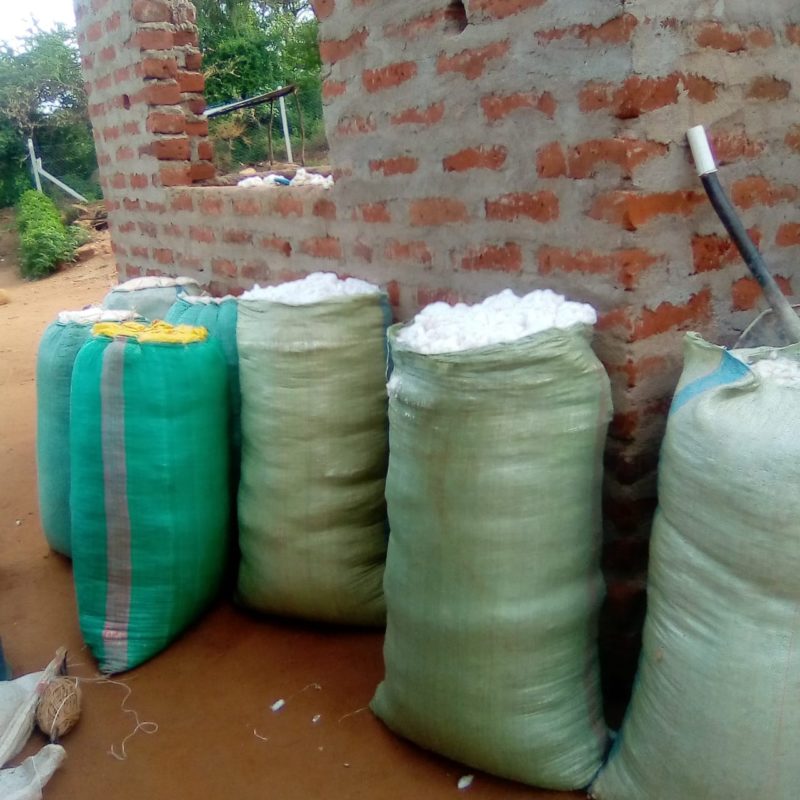Winfred Kasambu, a 50-year-old farmer and a grandmother of two from Kenya’s Eastern region, is cherishing high hopes of prosperity after realizing a bountiful harvest from her first crop of genetically modified Bt cotton.
Kasambu is one of the 1,000 farmers selected by the Kenyan government in March 2020 to receive the country’s first genetically modified (GM) insect-resistant cotton seeds.
Kasambu cultivated Bt cotton on one acre of her three-acre farm and grew a conventional cotton variety on another acre. The remaining area was devoted to maize and green grams (mung beans).
Though she planted the Bt cotton on Nov. 17, more than two weeks after she planted the conventional variety, the Bt cotton started yielding within four months.
“Today, I am so delighted that I have so far harvested 400 kilograms of Bt cotton and I’m continuing to pick more bales. The conventional variety I planted before the Bt cotton is yet to show any signs of maturity,’’ Kasambu noted, obviously impressed with her bountiful harvest as she pointed out the contrast between the two varieties.
“With Bt cotton, I have reduced the use of chemical sprays since I have only sprayed them three times while for the local [conventional] variety, I have so far sprayed six times and it still has a lot of pests. Caterpillar is a major challenge,” Kasambu lamented.

“From my experience with the crop, I can say that Bt cotton is a good seed. If the rains had been good, I could have harvested even much more cotton. Since I started farming cotton five years ago, I have not seen such high yields within such a short period,” she told the Alliance. “I will definitely continue planting Bt cotton. This time round I plan to stop planting maize to focus on cotton and green grams because I can buy maize for consumption from the money I get from the sale of my cotton produce.
“The next planting season, I will not wait for the rains,” she continued. “I will use water from the borehole for the July planting season since my daughter in-law has promised to install a solar panel to pump water into my farm.”
An overjoyed Kasambu noted that with the money she expects to get from this season’s harvest and subsequent harvests, she plans to extend her house, adding one more room and a putting up a new roof to conform with “digital standards.”
Like Kasambu, many Kenyan farmers are harvesting Bt cotton commercially for the first time since the government approved the crop. And they’re enjoying similar success.
Mugo Mangondu, a cotton farmer in Central Kenya, said that his Bt cotton matured early and that he is in final stages of harvesting the crop.
“My Bt cotton was ready for harvest this month after four to five months of planting,” he said, whereas conventional varieties usually take about one year to mature in his region due to cold seasons.
“Bt cotton means good business for us because we are selling it to ginneries early enough and can therefore focus on something else,” he said. “What I have observed with Bt cotton is that the stem is still sprouting even after harvesting, meaning that I can continue harvesting long after the first picking.”
He observed other benefits as well. “One stem of Bt cotton produces 40 bolls while conventional varieties produce 15 to 20 bolls. In addition, I have counted and measured. Bt cotton is a bit heavy and appears not to be prone to destruction by the cotton bollworm pest.”
“The remarkable progress indicated so far has convinced me to invest in Bt cotton seed. I will not wait to receive the seeds from the government like the last time. I hope the seeds can be available in my local agrovet so that I can purchase them, just like we conveniently access hybrid maize varieties,” Mangondu said.

Other farmers have taken note of his yields. “Farmers have started asking where they can get the seed. The government should invest in adequate seed production, especially now that we are expecting the long rainy season to set in.”
Mugo said he has saved money that otherwise would have been used to buy chemicals to spray the crop. “I used to spray nine to 12 times per season but with Bt cotton, I have only sprayed three times in the last season,” he happily told the Alliance. “The difference has enabled me to save time spent on spraying. It also saves me the time spent carrying knapsacks [to apply pesticides] to focus on other income generating activities.”
Dr. Charles Waturu, the principal investigator on the Bt cotton research project at the Kenya Agricultural and Livestock Research Organization (KALRO), said although cotton was planted late and experienced the challenge of inadequate rain in some regions, germination was good.
Out of the 16.3 metric tons of Bt cotton seeds distributed, cotton was planted and well-received by farmers although there were challenges on late distribution, he acknowledged.
“The revival of cotton production should not rely on free seeds from the government,” Waturu said in a phone interview with the Alliance. “Seed should now be available and accessible to farmers because farmers are ready to buy seed just as they do with hybrid seed varieties of various crops because of the value they get from the seed.”
Waturu said farmers should be able to access Bt seed any time they need it, noting that the Kenyan government’s Agriculture and Food Authority (AFA) and Mahyco Seed, a seed propagation company, are working towards meeting the demand whilst supporting farmers with agronomy knowledge.
Editor’s note: This article was revised to correct the maturation date of Mugo Mangondu’s cotton, which was originally written as seven months, to four to five months.
